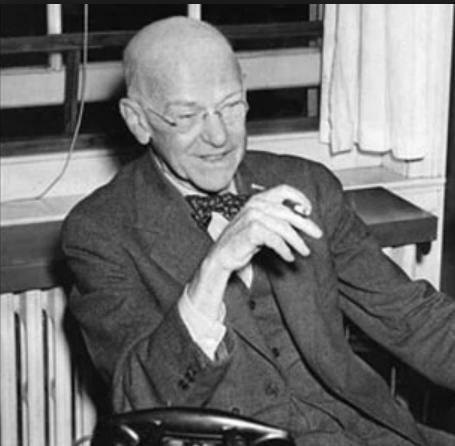
George Elton Mayo was a great psychologist and sociologist of the twentieth century, his theories and experiments contributed a more human vision to organizations and work. Elton Mayo is known for his famous Hawthorne experiments, in which he discovered the important and decisive weight that human value has in a job.
Do you want to know more about Elton Mayo and the Hawthorne Experiments? Then we recommend that you continue reading this article on Psychology-Online, in it you will find the story of May and his interesting Theory of human relations.
Index
- Elton Mayo and the Hawthorne Experiments
- Hawthorne's experiment
- Human factor study phase
- Critical phase of the Elton Mayo experiment
- Final phases of the Hawthrone experiment
Elton Mayo and the Hawthorne Experiments.
George Elton Mayo (1880-1949) worked for the Australian Army in World War I, later being influenced by Janet, who represented social conflict as a product of individual maladjustment, which leads him to insist on the value of counseling.
Moved to USA he studies in a textile industry, still from a mechanistic and individualistic perspective. Following his successes in these investigations, he is invited to work at Harvard, where he meets Henderson, who had studied physiological aspects of fatigue.
Mayo's theory of human relations
He is interested in the sociology and social anthropology. From Talcott Parsons he receives functionalist influences, a functional conception of conflict as a necessary sign of social pathology. Pareto collects the notion of non-logical action, arising from sentiment, and the conception of the fundamental role of the social elite. With all this he comes to the conclusion that the applied study of labor relations requires the integration of physiology, biochemistry, psychology, sociology, etc.
Human beings are not machines, and therefore, we do not deserve to be considered as such in our job.
This famous phrase defines very well Elton Mayo's idea of work and human value in organizations. In order to prove all of this, he performed a series of experiments known as the Hawthorne experiments. Next, we are going to explain what Elton Mayo's experiments consisted of:

Hawthorne's experiment.
In Hawthorne, in the factory of the Western Electric Company, he develops one of the most important experiments in this field, with the aim of examine working conditions and its relationship with production, determining and classifying the problems of the entire labor situation. There are four phases in the research program:
- Human factor study phase
- Critical phase
- Anthropological phase
- Manipulative phase
The main objective of this experiment was to establish and define the relationship between people's psychological well-being and their productivity. Next, we will describe all the phases of the Hawthrone experiment.

Study phase of the human factor.
Experiments on the relationship between lighting and production with inconclusive results. Others on biopsychological variables: group of six women transferred to a "test room" with controlled conditions and under observation. Fourteen successive conditions are established:
- Production record in the usual place, of other information and medical examination.
- Test room. Production decline.
- Confidence climate with the observer, a premium proportional to individual production.
- Production increase.
- Two daily breaks. Production increase.
- Increase in the time of the pauses.
- Production increase.
- Change of the two 10 'pauses for six of 5' decrease in production, complaints that the rhythm is broken and little rest
- Two breaks, one of 15 'and the other of 10' with a snack.
- Increase in production Increase in pause time. Production increase.
- Change of the two 10 'breaks for six of 5' decrease in production, complaints that the rhythm is broken and little rest is given.
- Two breaks, one of 15 'and the other of 10' with a snack. Production increase
- Previous breaks and half an hour less than the day. Production increase. They change to two due to conflicts.
- One hour less work with the same breaks, less daily and weekly performance, higher average hourly performance.
- Conditions of the 7th stage, complaints of fatigue, increased production, integration of the group. Day as in the previous one but without Saturdays. Increase yield, decrease production.
- Reinstatement of the normal working day. Increase in daily and weekly performance, decrease in production per hour.
- Conditions of the 7th, the company puts the drink and each one the food, the highest yields are achieved.
Conclusions from the human study phase
The 7th model is implanted and the conclusions drawn are a upward trend in performance independent of changes in breaks, and not due to the effect of novelty. Muscle fatigue is not a primary factor in performance. The test room seems more satisfactory for the workers, absenteeism decreases. Performance is more related to the type of working day than to the number of working days. The health of the operators is maintained or improved even with higher yields.
It is produced better work environment, greater eagerness to go with the new conditions of control and freedom. The benevolent observer makes them feel unhurried, a more trusting and sincere demeanor, and a sense of participation when consulting all the changes with what the group is constituted in a unit Social. Despite all this, from 1929 there is a deterioration in performance and concern for job security. Two other experiments are performed, one to determine the effects of the bonus, in which five workers increased their performance with it by 13% although conflicts were created with the other workers in the factory.
In another experiment the effects of the observer were tested, (Mica Spliting Test room[1]) five workers were isolated without giving them a bonus, over two years their privileges were increased, hourly production increased by 15% in the first year and decreased in the second without being able to create a group integrated.
Critical phase of the Elton Mayo experiment.
In the critical phase of the Elton Mayo experiment Workers' opinions are collected with interviews that are initially closed and then more open. The aim is to improve the supervision, which had become highly influential in the previous experiment. There are systematic variations in attitudes depending on the status of the interviewee. Finally, Counseling-type techniques are introduced to explore social feelings.
After preparing the information, it is concluded that the behavior of the worker does not depend so much on the individual personality as on the organizational characteristic - social constituted by the company. Spontaneous groups are important. A more sociological conception and methodology is needed.

Final phases of the Hawthrone experiment.
To finish explaining what Elton Mayo's experiments consisted of, we are going to define the final phases of the Hawthrone experiment:
Anthropological phase
Since 1932 the strategy of observation is adopted. An observation room is created in which fourteen workers work. It is discovered that despite the incentives, each group tends to set a production standard implicitly and those who do not submit to it are pressured.
Front-line supervisors are also seen to tolerate it, in addition to tolerating other infractions. There are therefore two mechanisms: Compliance with implicit rules and sanctions if not followed, and group identity mechanisms (nicknames, etc.) as well as informal leadership roles.
Manipulative phase
After the economic depression, the investigation is established as personal advice, however the directors adopt a manipulative role that is considered socially reprehensible. As a result of all these investigations, the existence of two superimposed structures, the formal and the informal, is revealed, but The most important thing is that the importance of preparing managers and supervisors is seen, of giving greater importance to the problem of administration. The main part of the industry is social and human, and not economic, so the main skills are those of leadership and counseling. A man and a community do not function as a mechanism.
This article is merely informative, in Psychology-Online we do not have the power to make a diagnosis or recommend a treatment. We invite you to go to a psychologist to treat your particular case.
If you want to read more articles similar to Elton Mayo and the Hawthorne Experiments, we recommend that you enter our category of Social and Organizational Psychology.
References
- Brannigan, A., & Zwerman, W. (2001). The real "hawthorne effect". Society, 38(2), 55-60.


